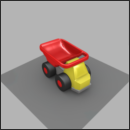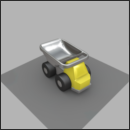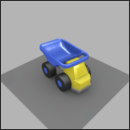Preparing a Model
A configuration, or product variant, consists of a set of layers.
Creating a variant can be thought of as defining which layers among those you have prepared will be visible and which will be hidden. Consequently, creating configurations depends on having prepared product layers before you define the configuration rules.
Sections Understanding Partitions and Using Meaningful Layer Names will help you think about layers used in configurations, and how to name and group layers in order to create configurations.
If you need more information on creating layers, documentation dedicated to aspect, position, and environment layers is available.
Understanding Partitions
 |  |  |
A partition with three possible states.
To create a configurable model, begin by identifying the partitions within which several alternatives are possible. In the above image, the truck’s bin can exist in multiple colors. The bin color is an example of a partition. Partitions can be related to model surface geometry, aspect or position, or the environment of the model. In this example, for ease of understanding, aspects, and colors are used to illustrate the principles of configurations.
There are two types of partitions. Some can be enabled or disabled, while others require an element to be chosen from a list of multiple alternatives. Partitions are listed in the Configuration Browser, where you or your end user can select their state:
Next, the partitions must be associated with rules.
In the above image, the partition "stickers" can be enabled or disabled. By ticking the checkbox "stickers" (on the left in the image), you define the corresponding symbol. The associated rule, "stickers" (on the right), states that when the symbol "stickers" is defined, the aspect layer containing the stickers is visible.
In this image, the partition "paint" refers to the color of the paint, which can be any one of several options: red, blue, yellow, black… By making a selection in the drop-down list (on the left of the image), you define one of the symbols "paint.red", "paint.blue", "paint.yellow", "paint.black" in accordance with your choice. The associated rules (on the right), "paint.red", "paint.blue", "paint.yellow", "paint.black," state that if the corresponding symbol is defined, the layer with the right color is visible.
This example, therefore, contains a total of five symbols and five rules (one for the stickers and four for the paint), but only two partitions ("stickers", and "paint").
Using Meaningful Layer Names
It is highly recommended that you give your geometry, position, illumination, aspect, overlay, and environment layers meaningful names. A meaningful name expresses the layer’s function clearly. This will greatly simplify the procedure of creating target layers for the rules governing your configurations.
Where configurations are concerned, using meaningful names does not only mean using names that allow you to remember what the layer is and does. It also means using names that allow you to make the connection between the layers themselves and the eventual configuration symbols and partitions that you will create.
Name your layers according to the partition they will belong to.
Give the same prefix to all layers referring to the same configurable element, or partition. If the layer is part of a group of options in a single partition, like the paint partition in the example above, we recommend using a multi-part name constructed as follows:
use the partition name as a prefix,
followed by a point (.),
followed by a meaningful descriptor.
This will lead to layer names such as "paint.red" for an aspect layer with red paint, or "lever.raised" for a position layer in which a lever is in the up position.
When you create configuration rules, you will be able to use meaningful layer names to automatically generate simple rules and their symbols in the appropriate format.
If you wish to rename an aspect layer, Patchwork 3D will then suggest that you rename the configuration rules and the linked symbols for you. Patchwork 3D will also offer to rename the symbols when a configuration rule changes its name.